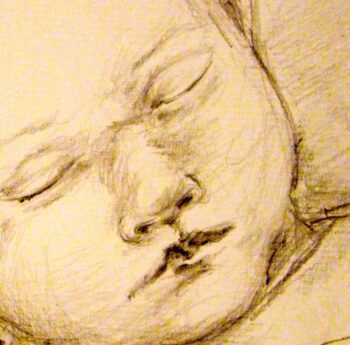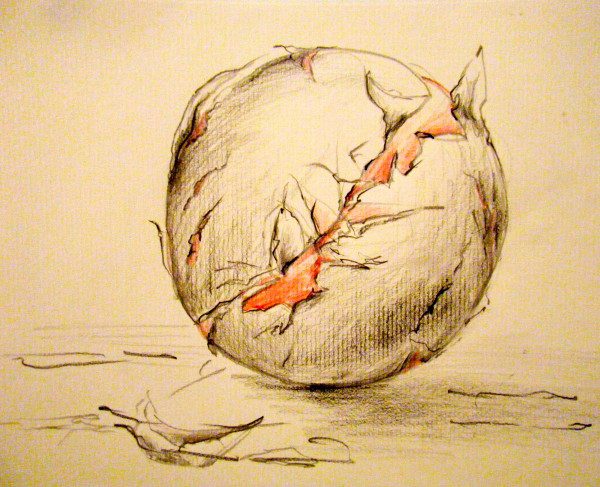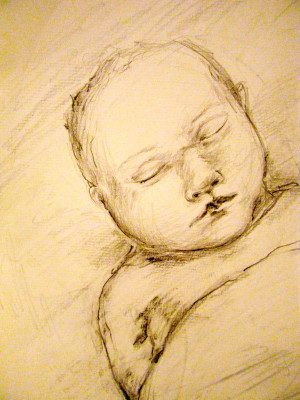
The birth story must always start the same way: with a woman in pain. There’s no avoiding the pain. The pain is how you know it’s beginning. It’s the overture, the epigraph, the amuse-bouche. You sit up straight. You stand up. You walk around. You move as if the pain is something you can twist away from, like pulling your hand from a hot stove. But this pain is coming from inside. This pain is trying to twist away from you. But first it has to come through you. First it has to open you up.
The woman shouldn’t take any pain medication. She’s a goddess, a woman-warrior, a thing built for this brutality. Without the pain, she won’t have earned her baby. His head won’t smell as sweet, his cheeks won’t dimple evenly. He won’t nurse well or sleep well or make the proper decile on his SAT exams. The pain is important, is what I’m saying. I’m saying there is a right way and a wrong way to tell a birth story.
Act one takes place in the bedroom with a sudden awakening in the middle of the night. Or it takes place in a car with a slow crescendo of breath, of furrowed brow. It might take place in a restaurant with a feeling like a joint moving out of place and a fast rush of liquid, warm, so warm, then cold.
The drama doesn’t really get going until act two, after the scene change. Let’s say she’s at the hospital now, in a room not unlike a hotel room, only here everything is connected to everything else through a series of wires. There are so many wires you couldn’t count them even if you had the next fourteen hours to do nothing but sit in the room and breathe and try to forget about the pain. The bed is connected to the computer. The computer is connected to the monitor on the woman’s belly. The woman is connected to the blood pressure cuff that squeezes, squeezes, every ten minutes squeezes. The cuff is connected to a control panel. The panel is connected to an IV pole and a bag of clearish fluid. The fluid is connected to the woman’s arm, straight to her artery, straight through everything her body has built around itself to keep things like this out. Her artery is connected to the baby. Everything is thrumming with electricity. The whole room feels charged, like it’s holding its breath and she’s the only thing in the world still breathing.
All this time passes, but the plot of the birth story moves slowly. New characters come in: doctors, nurses, residents, the anesthesiologist, her steady husband, who sometimes touches her forehead when she closes her eyes. Someone pokes her between her legs and her body exhales fluid mixed with blood. They say there’s no predicting when it will be over.
This is the part of the birth story when the woman is supposed to tap into the primal strength of her ancestors, a pool with a hundred thousand years of depth, and all at once, she hears screaming that is not her own and there is a new person in the room—whole and elaborate and not just a body, but a person.
This is the correct way to tell a birth story.
But there are other versions, too. There are rougher drafts. Say she reaches into herself, into the pool of strength, and finds it dry. Say she panics. Say she looks to her husband, her whole body shaking, and steadies herself long enough to whisper, “I can’t do it.” She wants to stop but she doesn’t know how to stop, or what will happen to her if she stops, and no one will help her stop no matter how many times she asks. They just keep telling her to push and breathe and she does because there is nothing else she can think to do.
Until, finally, something beeps angrily and she is breathing through an oxygen mask and the doctor arrives in his blue vestments and says something about the baby’s heart rate and how when the baby is tired, it is time to stop.
In the end, after days of hard labor and hours of pushing with all the strength she has and some she didn’t know she had, the baby will not turn. The doctor has to go in and get him with giant metal forceps while the woman fogs the oxygen mask with her hot breath. And then it is over. For the first time in three quarters of a year, she is the only person in her body.
After that, something strange happens to her memory and she couldn’t tell you the rest of the birth story even if she wanted to.
There are a few pictures. She looks at them sometimes, by herself. She sees a tired-looking woman holding a baby close to her heart. What a lovely moment, she thinks, but it is not a memory she can conjure. It doesn’t belong to her and the baby is so little, only a dozen or so breaths into this life, she can’t imagine he will remember it either. Perhaps it belongs to no one. Perhaps it doesn’t exist at all.
But she takes him home with her: the proof of the story and of her body’s strengths and its weaknesses. She has touched every inch of him over and over and over again with her fingertips and her lips and the walls of her throbbing uterus. She kisses him and hugs him and presses her face against his and watches him breathe in the dark.
She knows, even if he doesn’t, that there was a time when her body was his whole universe. That’s part of the story, too, the part she most likes to remember.
***
Rumpus original art by Clare Nauman.






